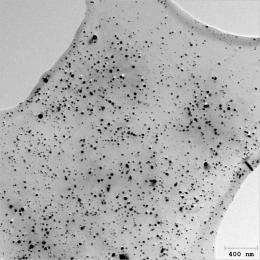Electronic salmon sandwich is paving the way towards cost-effective DNA memory device

In order to find a method for more cost-effective data storage, a group of researchers from the DFG-Center for Functional Nanostructures (CFN) at the Karlsruhe Institute of Technology (KIT) in Germany and the National Tsing Hua University in Taiwan have created a DNA-based “write-once-read-many-times” (WORM) memory device.
The device consists of a thin film of salmon DNA, which has been embedded with nano-sized particles of silver and then sandwiched between two electrodes. Ultraviolet light is used to encode information. The concept is published in Applied Physics Letters.
The collaboration on these devices started more than a year ago, and was a productive cross-field/cross-country endeavor. Dr. Ljiljana Fruk heads an interdisciplinary research group at the CFN concerned with DNA nanotechnology, biofunctionalization and light triggered nanodevice design and was involved in the development of the light triggered, DNA templated nanoparticle production and its characterization. Dr. Yu-Chueh Hung’s group on the other side used this knowledge to optimize the process and design the functional memory device. The transmission electron microscope (TEM) images of the nanoparticles in the DNA were obtained in turn by the Nanostructure Service Laboratory in the CFN.
As described in the article, shining UV light on the system causes the silver atoms to cluster into nano-sized particles. These particles provide the platform for the data encoding. The device is able to hold charge under a low current, which corresponds to the off-state. Under a high electrical field the charges pass through the device, which then corresponds to the on-state the device.
The team in Taiwan found that once the system had been turned on, it stayed on; changing the voltage across the electrodes did not change the system’s conductivity. This means that information can be written to the device but not overwritten. Once written, the device appears to retain that information indefinitely. The researchers report that the material’s conductivity did not change significantly during nearly 30 hours of tracking.
The authors expect the technique to be useful in the design of optical storage devices and suggest that it may have plasmonic applications as well. This work combines new advances in DNA nanotechnology with conventional polymer fabrication platform to realize novel DNA-based organic devices. It demonstrates new possibilities to fabricate novel, cheaper and bio friendly devices by integrating and merging several fields of interest.
More information: Appl. Phys. Lett. 99, 253301 (2011); doi:10.1063/1.3671153
Provided by Karlsruhe Institute of Technology

















